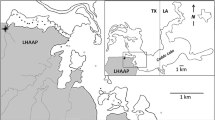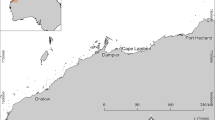Abstract
Acute, laboratory toxicity tests were performed by the National Oceanic and Atmospheric Administration (NOAA) on 1543 surficial sediment samples collected during 1991 through 1997 throughout 25 estuaries and marine bays. Selected areas were sampled along the Atlantic, Gulf of Mexico, and Pacific coasts. The toxicity of each sample was determined with 10-day amphipod survival tests performed with solid-phase (bulk) sediments. Collectively, the 1543 samples tested through 1997 represented a total area of approximately 7300 km2. Toxicity was observed with the amphipod survival tests in samples that represented approximately 6% of the combined area. Using similar tests conducted on samples collected in different, but overlapping, study areas, the U.S. Environmental Protection Agency (EPA) estimated that approximately 7% of the combined estuarine area sampled was toxic. Generally, toxicity was most severe in northeastern and southwestern estuaries and least prevalent in southeastern and northwestern areas. However, considerable portions of the Pacific coast have not been tested with the same methods. In tests of CYP1A enzyme induction (n=464), samples were toxic that represented about 5% of the combined study areas. Toxicity was much more widespread, however, when the results of two sub-lethal tests were analyzed. Significant results occurred in samples that represented approximately 25% and 39% of the study areas in tests of sea urchin fertilization (n=1309) and microbial bioluminescence (n=1215), respectively.
Similar content being viewed by others
References
ASTM: 1993, Standard guide for conducting solid phase, 10-day, static sediment toxicity tests with marine and estuarine infaunal amphipodsASTM E 1367–92, American Society for Testing Materials. Philadelphia, PA, 24 pg.
Anderson, J.W., Rossi, S.S., Tukey, R.H., Vu, T. and Quattrochi, L.C.: 1995, ‘A biomarker, P450 RGS, for assessing the potential toxicity of organic compounds in environmental samples’ Environmental Toxicology and Chemistry 14, 1159–1169.
Bay, S.M.: 1996, Sediment toxicity on the mainland shelf of the Southern California Bight in 1994, SCCWRP Annual ReportSouthern California Coastal Water Research Project, Long Beach, CA, p. 128–135.
Carr, R.S.: 1997, ‘Marine and estuarine porewater toxicity testing’ in: Chapter 36: Microscale Testing in Aquatic ToxicologyWells, P. G., Lee, K. and Blaise, C. (eds.), CRC Press, Boca Raton, FL, pp. 523–538.
Chapman, P.M.: 1995, ‘Do sediment toxicity tests require field validation?’ Environmental Toxicology and Chemistry 14, 1451–1453.
Chapman, P.M., Dexter, R.N. and Long, E.R.: 1987, ‘Synoptic measures of sediment contamination, toxicity and infaunal community composition (the Sediment Quality Triad) in San Francisco Bay’ Marine Ecology Progress Series 37, 75–96.
Heimbuch, D., Wilson, H., Seibel, J. and Weisberg, S: 1995, R-EMAP data analysis approach for estimating the proportion of area that is subnominalPrepared for U.S. Environmental Protection Agency, Research Triangle Park, NC, 22 pp.
Hill, I.R., Matthiessen, P. and Heimbach, F.: 1993, Guidance document on sediment toxicity tests and bioassays for freshwater and marine environmentsWorkshop on Sediment Toxicity Assessment held at Slot Moermond Congrescentrum, Renesse, The Netherlands. Society of Environmental Toxicology and Chemistry-Europe, 105 pp.
Hyland, J., Herrlinger, T., Snoots, T., Ringwood, A., VanDolah, R., Hackney, C., Nelson, G., Rosen, J. and Kokkinakis, S.: 1996, Environmental quality of estuaries of the Carolinian Province: 1994, NOAA Technical Memorandum 97, National Oceanic and Atmospheric Administration, Charleston, SC.
Hyland. J.L., Balthis, L., Hackney, C.T., MacRae, G., Ringwood, A.H., Snoots, T.R., VanDolah, R.F. and Wade, T.L.: 1998, Environmental quality of estuaries of the Carolinian Province, 1995NOAA Technical Memorandum NOS ORCA 123, National Oceanic and Atmospheric Administration, Charleston, SC.
Ingersoll, C.G., Ankley, G.T., Baudo, R., Burton, G.A., Lick, W., Luoma, S.N., MacDonald, D.D., Reynoldson, T.B., Solomon, K.R., Swartz, R.C. and Warren-Hicks, W.J.: 1997, ‘Workgroup summary report on uncertainty evaluation of measurement endpoints used in sediment ecological risk assessments’ in: Chapter 18: Ecological Risk Assessment of Contaminated Sediments.SETAC Special Publication. Society of Environmental Toxicology and Chemistry, Pensacola, FL., Ingersoll, C. G., Dillon, T. and Biddinger, G. R. (eds.), pp. 271–296.
Johnson, B.T. and Long, E.R.: 1998, ‘Rapid toxicity assessment of sediments from estuarine ecosystems: Anew tandem in vitrotesting approach’ Environmental Toxicology and Chemistry 17, 1099–1106.
Lauenstein, G.G. and Cantillo, A.Y.: 1993, Sampling and analytical methods of the National Status and Trends Program, National Benthic Surveillance and MusselWatch Projects. 1984–1992. Volume 1 Overview and summary of methodsNOAA Technical Memorandum NOS ORCA 71, National Oceanic and Atmospheric Administration. Silver Spring, MD, 117 pp.
Long, E.R. and Chapman, P.M.: 1985, ‘A sediment quality triad: Measures of sediment contamination, toxicity and infaunal community composition in Puget Sound’ Marine Pollution Bulletin 16, 405–415.
Long, E.R. and Morgan, L.G.: 1990, The potential for biological effects of sediment-sorbed contaminants tested in the National Status and Trends ProgramNOAA Technical Memorandum NOS OMA 52, U.S. National Oceanic and Atmospheric Administration. Seattle,WA, 175 pp.
Long, E.R. and Markel, R.: 1992, In evaluation of the extent and magnitude of biological effects associated with chemical contaminants in San Francisco BayCalifornia, NOAA Technical Memorandum NOS ORCA 64, National Oceanic and Atmospheric Administration. Seattle,WA., 86 pp.
Long, E.R., Robertson, A., Wolfe, D.A., Hameedi, J. and Sloane, G.M.: 1996, ‘Estimates of the spatial extent of sediment toxicity in major U.S. estuaries’ Environmental Science and Technology 30, 3585–3592.
Long, E.R. and MacDonald, D.D.: 1998, ‘Recommended uses of empirically derived, sediment quality guidelines for marine and estuarine ecosystem’ Journal of Human and Ecological Risk Assessment 4, 1019–1039.
Long, E.R., Hameedi, J., Robertson, A., Aasen, S., Dutch, M., Ricci, C.,Welch, K., Kammin,W., Carr, R.S., Johnson, T., Biedenbach, J., Scott, K.J., Mueler, C. and Anderson, J.W.: in press, Sediment Quality in Puget Sound. Year 1-Northern Puget SoundNOAA Technical Memorandum NOS NCCOS xxx, National Oceanic and Atmospheric Administration, Silver Spring, MD.
NRC: 1989, Contaminated marine sediments-assessment and remediationNational Academy Press, National Research Council, Washington, DC, 493 pp.
NOAA: 1989, National Status and Trends Program for Marine Environmental Quality Progress Report. A summary of data on tissue contamination from the first three years (1986–1988) of the Mussel Watch ProjectNOAA Technical Memorandum NOS ORCA 49, National Oceanic and Atmospheric Administration, Silver Spring, MD.
Overton, W.S., White, D. and Stevens, D.L.: 1991, Design report for EMAP Environmental Monitoring and Assessment ProgramEPA/600/3-91/053, U.S. EPA, Office of Research and Development, Washington, DC, 52 pp.
Paul, J.F., Scott, K.J., Holland, A.F., Weisberg, S.B., Summers, J.K. and Robertson, A.: 1992, ‘The estuarine component of the U.S. EPA's environmental monitoring and assessment program,’ Chemistry and Ecology 7, 93–116.
Power, E.A. and Chapman, P.M.: 1992, ‘Assessing sediment quality’ in: Sediment Toxicity AssessmentBurton, G. A. Jr. (Ed.), Lewis Publishers, Inc. Boca Baton, Fl, pp.1–18.
Schiewe, M.H., Hawk, E.G., Actor, D.I. and Krahn, M.M.: 1985, ‘Use of a bacterial bioluminescence assay to assess toxicity of contaminated marine sediments’ Canadian Journal of Fisheries and Aquatic Science 42, 1244–1248.
Schimmel, S.C., Melzian, B.D., Campbell, D.E., Strobel, C.J., Benyi, S.J., Rosen, J.S. and Buffum H.W.: 1994, Statistical Summary. EMAP-Estuaries. Virginian Province-1991EPA 620/R-94/005, U.S. Environmental Protection Agency, Washington, DC, 77 pp.
Strobel, C.J., Buffum, H.W., Benyi, S.J., Petrocelli, E.A., Reifsteck, D.R. and Keith, D.J.: 1995, Statistical Summary. EMAP-Estuaries. Virginian Province-1990 to 1993EPA/620/R-94/-26, U.S. Environmental Protection Agency, Narragansett, RI, 72 pp.
Summers, J.K. and Macauley, J.M.: 1993, Statistical summary: EMAP-Estuaries Louisianian Province-1991EPA/600/R-93-001, EPA, Office of Research and Development, Washington, DC, 101 pp.
Swartz, R.: 1989, ‘Marine sediment toxicity tests’ in: Contaminated marine sediments-assessment and remediationNational Research Council, National Academy Press. Washington, DC, pp.115-129.
Swartz, R.C., DeBen, W.A., Sercu, K.A. and Lamberson, J.O.: 1982, ‘Sediment toxicity and the distribution of amphipods in Commencement Bay,Washington, USA’ Marine Pollution Bulletin 13, 359–364.
Swartz, R.C., Cole, F.A., Schults, D.W. and DeBen, W.A.: 1986, ‘Ecological changes on the Palos Verdes Shelf near a large sewage outfall: 1980–1983’ Marine Ecological Progress Series 31, 1–13.
Swartz, R.C., Cole, F.A., Lambertson, J.O., Ferraro, S.P., Schults, D.W., DeBen, W.A., Lee, H II and Ozretich, R.J.: 1994, ‘Sediment toxicity, contamination and amphipod abundance at a DDT-and dieldrin-contaminated site in San Francisco Bay’ Environmental Toxicology and Chemistry 13, 949–962.
Thursby, G., Heltshe, B.J. and Scott, K.J.: 1997, ‘Revised approach to toxicity test acceptability criteria using a statistical performance assessment’ Environmental Toxicology and Chemistry 16, 1322–1329.
Turgeon, D.D., Hameedi, J., Harmon, M.R., Long, E.R., McMahon, K.D. and White, H.H.: 1998, Sediment toxicity in U.S. coastal watersNational Oceanic and Atmospheric Administration, Silver Spring, MD, 20 pp.
USEPA: 1994a, Proceedings of the national sediment inventory workshopEnvironmental Protection Agency, Office of Water, Washington, DC, 23 pg.
USEPA: 1994b, EPA's contaminated sediment management strategy823-R-94-001, Environmental Protection Agency, Office of Water, Washington, DC, 130 pp.
USEPA: 1997, The incidence and severity of sediment contamination in surface waters of the United StatesEPA 823-R-97-006, Environmental Protection Agency, Office of Science and Technology, Washington, DC.
Author information
Authors and Affiliations
Rights and permissions
About this article
Cite this article
Long, E.R. Spatial Extent of Sediment Toxicity in U.S. Estuaries and Marine Bays. Environ Monit Assess 64, 391–407 (2000). https://doi.org/10.1023/A:1006407621853
Issue Date:
DOI: https://doi.org/10.1023/A:1006407621853




